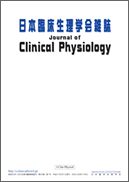Volume 51, Issue 5
Journal of Clinical physiology
Displaying 1-6 of 6 articles from this issue
- |<
- <
- 1
- >
- >|
Review
-
2021 Volume 51 Issue 5 Pages 157-158
Published: December 01, 2021
Released on J-STAGE: June 09, 2022
Download PDF (339K) -
Long-term Management of Shock Leads and Role of Subcutaneous Implantable Cardioverter Defibrillators2021 Volume 51 Issue 5 Pages 159-162
Published: December 01, 2021
Released on J-STAGE: June 09, 2022
Download PDF (825K)
-
2021 Volume 51 Issue 5 Pages 163-170
Published: December 01, 2021
Released on J-STAGE: June 09, 2022
Download PDF (810K)
Original Paper
-
2021 Volume 51 Issue 5 Pages 171-177
Published: December 01, 2021
Released on J-STAGE: June 09, 2022
Download PDF (604K) -
2021 Volume 51 Issue 5 Pages 179-184
Published: December 01, 2021
Released on J-STAGE: June 09, 2022
Download PDF (366K) -
2021 Volume 51 Issue 5 Pages 185-189
Published: December 01, 2021
Released on J-STAGE: June 09, 2022
Download PDF (317K)
- |<
- <
- 1
- >
- >|
